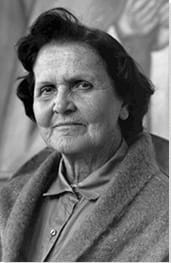Summary of Débora Arango
Arango was one of Colombia's most original and fearless 20th century artists. With a single-mindedness that saw her reject all expectations for a well-educated middle-class Catholic, she pursued a career, not only as a female artist, but one who produced works that presented a blunt challenged to Colombian culture and its artistic traditions. Struggling against censor and defamation, her work ignited sharp criticism from conservative and religious bodies. Her art examined issues related to sexuality, class, political corruption, religious hypocrisy, and the struggles facing vulnerable Colombian women. Her expressionistic treatment of these topics was unflinching and unapologetic. Like Frida Kahlo, her more famous Mexican counterpart, Arango helped her country come to terms with its rapid modernization.
Accomplishments
- Arango made her first impact on the Colombian art scene as a painter of the female nude. Works such as La Amiga (1939) were nothing short of scandalous and earned her a reputation as a firebrand who was roundly attacked by the conservative press. It was significant in itself that a female artists should dare to venture into such a genre, but Arango also instigated a shift in how the female body was represented, namely through the gaze of another woman rather than an adoring man.
- Arango used her art to confront social issues, and specifically problems faced by ordinary Colombian women. Her position was unique in that her brothers were well connected within the medical world and through them she gained access to environments that would otherwise be out of bounds to a female artist, including morgues, asylums, and prisons. These works directly addressed the links between incarceration and mental illness and were a blatant afront to what was deemed appropriate subject matter for female artists to tackle.
- Arango used her art to respond directly to one of the most difficult episodes in her country's history, known as La Violencia (The Violence). She chronicled the riots that followed a presidential assassination through chaotic and violent watercolors, such as Masacre del 9 de Abril (1948) and El tren de la muerte (The Train of Death) (1948). These works offered final confirmation that Arango had abandoned her early career credo that her art would be free of an obligation to address itself to any kind of social responsibility.
- Arango's commitment to represent the daily hardships facing Colombia's women grated with the country's Catholic elders. Her relationship with the church reached its lowest point with what was perhaps her most notorious painting, Madona del Silencio (1944). The painting shows a prison inmate having just given birth in her cell (with mother and baby still attached by umbilical cord). By offering a title that linked her image with the most sacred icon in Catholic culture, the Virgin Mary, Arango drew the ire of the archbishop of Colombia who went so far as to threaten the artist with ex-communication.
The Life of Débora Arango
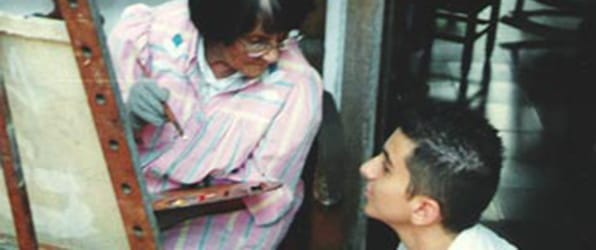
Arango's career was built on studies of the female nude, "Without experience in nudes", she declared, "no ambitious artist devoted to art can say that he [or she] has completed his [or her] work".
Important Art by Débora Arango
La Amiga (The Friend)
La Amiga (1939) is one of the nine watercolors Arango selected to exhibit in the Salon of Professional Artists in Club Unión in Medellín - the artist's home city. The nude would spark the first of many scandals concerning Arango's subject choices. The painting shows a woman sleeping or resting, face down in a relaxed pose atop purple-red sheets. Her back and buttocks are on display, with only a piece of white fabric covering he thighs. Her face rests on her hand while she carries the expression of a woman fully at peace. Her body, which dominates the composition, features rounded shapes and tanned skin with some red tones that give the subject the look of a younger woman. The artwork is also striking for its scale, with Arango creating a life-size nude by joining sheets of paper that measure 144 cm wide.
La Amiga, and another exhibition piece of a similar size, provoked criticism. The conservative newspaper La Defensa condemned the watercolor as an artwork that would only be "appropriate for hanging in a brothel". Arango was quick to remark that, although other nudes in the Club Unión Exhibition were not considered controversial, hers were "different because I was a woman". The artist, who called on the help of her sisters and female friends to pose as her models, had put down her marker as probably the first Columbian woman to paint female nudes. La Amiga, introduced a substantial shift in how the female body was represented; that is, through the gaze of another woman rather than a man.
Watercolor - Museo de Arte Moderno de Medellín, Medellín
Hermanas de la caridad (Sisters of Charity)
Having been educated in Catholic schools run by nuns, Sisters of Charity depicts a scene drawn from Arango's own upbringing. A group of nuns is gathered, some standing, some sitting, all dressed in a simple black dress with their heads covered by white flapped wimples. The nuns, who face in many different directions, takes up most of the canvas and are placed against a dark background of blue, purple, green, and ochre tones, thus creating a strong contrast with their wimples and blouses. The dark background tones form a series of parallel lines that could be a wall or tree trunks. Further back in the far distance, a series of hills in green, purple, and blue tones can be seen set against a light blue and cloudy sky.
The three-man jury awarded Sisters of Charity the first prize at the exhibition at Club Unión. Despite the controversy her nudes had created within the church hierarchy, Arango remained a practicing Catholic and this piece sat more comfortably with the conservative tastes of the church and the Colombian people. And yet the announcement of the prize only served to generate press criticism. As former curator of the Museo de Arte Moderno de Medellín, and longtime friend of Arango, Alberto Sierra, pointed out, Sisters of Charity was problematic, not because of its subject matter, but because the artist had exhibited female nudes and religious paintings side-by-side. Despite the hostile press reaction, the win led to a rise in Arango's profile and her first solo exhibition in Bogotá (Columbia's capital) soon followed.
Oil on maguey fiber - Museo de Arte Moderno de Medellín, Medellín
Esquizofrenia en la cárcel (Schizophrenia in jail)
Schizophrenia in jail is one of the first artworks in which Arango confronted social issues, and specifically problems faced by underrepresented Colombian women. Her figure bosses the center of the composition: she is depicted in an emerald-green dress in a dynamic pose with her legs wide open and her arms raised; her limbs showing a certain rigidity. Her dress creeps upwards, and her "angry" breasts are visible through its sheer fabric. The subject's intense and aggressive expression captures her internal suffering as she stares down the viewer. For the background, Arango chooses dark ochres and reds to depict the sparse room. The only elements visible are a simple bed, with unmade white bedcovers, and a series of posters with sexual references. The scene is expressionistic and a long way removed from romantic and naturalistic representations of women more familiar to Latin American art.
Through her brothers' connections to the medical world, Arango had access to morgues, asylums, and prisons with the result that she became increasingly aware of the desperate situations faced by women in these environments. This artwork represents a woman who has been incarcerated because of a mental illness and Arango was the first Colombian artist to address such a taboo topic (and so candidly too). Her works in this idiom offered both a blunt challenge to the anti-reform Colombian culture, and a blatant afront to what was considered appropriate subject matter for female artists to tackle. Arango had in fact declared that art should be free of an obligation to address itself to any kind of social responsibility, but as her career gathered pace, she became more and more engaged with the inequalities and injustices she observed around her.
Oil on canvas - Museo de Arte Moderno de Medellín, Medellín
Madona del silencio (Madonna of Silence)
Madona del Silencio shows a more developed approach in Arango's exploration of issues relating to the lives of subaltern women. The unnamed woman sits on the floor with her are legs opened towards the spectator. She is wearing only a striped shirt that is open to reveal her bare breast. Her gaze is fixed on the baby to which she has just given birth. Mother and child are still attached by the umbilical cord. Arango has chosen earthy tones, with a set comprising only a deep brown floor and two walls, creating a forbidding atmosphere. No further details are needed for the viewer to know this is an unsafe and unsanitary place to give birth. The color choices contrast starkly with the spotless sanitary image that comes to mind when thinking of a hospital (the safe and appropriate setting for a woman to give birth). The representation also reveals the expressionistic approach with which Arango is now becoming more comfortable.
The painting documents an event Arango witnessed while visiting the Good Shepherd's women's prison. It breaks with the idealization of motherhood common throughout art history and focuses rather on the harsh and dangerous circumstances in which some women become mothers. The title of the artwork is highly provocative in the sense that it alludes to that most idealized image of motherhood in Catholic culture, the Virgin Mary. Arango's approach, even daring to link these images to the Catholic discourse, did not come without condemnation and repercussions with the archbishop of Colombia threatening Arango with ex-communication.
Oil on canvas and hardboard - Museo de Arte Moderno de Medellín, Medellín
Masacre del 9 de abril (Massacre of April 9th)
The watercolor Masacre del 9 de Abril marks the start of a new political phase of Arango's art. The scene is more crowded and dynamic than her earlier works. The artist renders many grotesque human figures, mostly wearing civilian clothing. The figures gather and climb a church bell tower. Most of the figures have intense and contorted facial expressions. A woman is placed atop the bell tower, holding the bells in her hands with her legs open as another character peaks between them. On the side, a series of figures in priestly attire try to climb towards the top of the tower via a ladder. The scene is chaotic and happens as fire burns in the background representing the catastrophe facing the country in the wake of the assassination of liberal presidential candidate Jorge Elicer Gaitán. It was a period in Colombian history simply called La Violencia (The Violence).
The riots themselves would become known as the Bogotazo. Fearful citizens retreated indoors. Arango listened to radio reports of murder and violence and it was these bulletins (rather than witnessing events firsthand) that provided the source of her visceral response to the rioting. The director of the Museum of Modern Art of Medellín, Mercedes Gonzalez, noted that cultural institutions sought to operate normally during Bogotazo. Gonzalez states, "There was a very powerful social will, a barrier of resistance, and, despite war and economic crisis, this city was resilient". In the following decade, Arango would continue to produce images that chronicled and critiqued the many political upheavals facing the Colombian people.
Watercolor - Museo de Arte Moderno de Medellín, Medellín
El tren de la muerte (The Train of Death)
El tren de la Muerte was a further response to the violence in which Colombia's corrupt government was complicit. The artist depicts a series of lifeless bodies taken away inside a train car. The train creates a serpentine diagonal line that runs from the bottom left corner, towards the upper right corner of the composition, and gray smoke emanates from the train covering the night sky. The artist chooses gray and light blue to depict the metal train car, which contrasts with the bloodied hand imprints on either side of the open car door. Inside, the faces carry frozen expressions of horror. The angry gestural brushstrokes are especially marked on the upper painting which represents either the sky or the rolling stem from the train engine.
The painting comments explicitly on the use of trains by the government during La Violencia to transport thousands of detainees and murdered citizens. This artwork, more than any other perhaps, shows the influence of studying José Clemente Orozco's style, and closely resembles Orozco's The Trench (1926). Commenting on Arango's political paintings, art historian Santiago Londoño observes: "There is no embellishment or political allegory. Only a naked bold and urgent artistic testimony". This political phase of Arango's work remained hidden by the government for almost two decades.
Watercolor - Museo de Arte Moderno de Medellín, Medellín
Biography of Débora Arango
Childhood
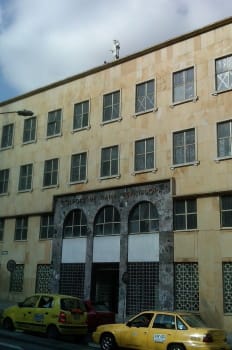
Débora Arango Pérez was born in Medellín, Colombia's second-largest city. Located in the central region of the Andes Mountains, it is commonly referred to as the "City of the Eternal Spring" due to its mild climate. The daughter of Castor María Arango, a successful merchant, and Elvira Pérez Débora, she was the seventh of 11 siblings. The family were devout Catholics and, like most of her local community, she attending daily mass. In spite of her strict religious upbringing, Arango developed a rebellious side. Encouraged by relatives, she would disguise herself as a boy and go horse riding (an activity then prohibited to girls) and her father even allowed her to take the wheel of the family car ("In those times in Medellín", Arango later recalled, "there were three women who drove: a foreigner, the daughter of a trucker and me"). Having free reign of her aunt's library, she also discovered philosophers and writers, and through her brothers' text books (they were medical students), she was able to study human anatomy.
Arango followed a strict religious education, as was expected of a girl of a good Catholic upbringing. She first attended school with the sisters of La Presentación (an international Catholic network committed to the education of "young ladies") before continuing her education at the María Auxiliadora School. The female curriculum mainly focused on tasks that would qualify women for motherhood and domestic life, such as dressmaking and the culinary arts, with some emphasis on music and painting. However, one sister, María Rabaccia, identified Arango's artistic abilities and encouraged her to pursue a career as an artist. Her sex excluded her from the qualification a bachelor's degree in art, and Arango left education instead with a general "certificate of studies".
Early Training and Work
Arango pursued her interest in painting in 1931 through private training with the Columbian painter Eladio Vélez who had recently returned to Medellín from a tour of Europe. Her time with Vélez allowed Arango to develop her watercolor technique through classes mainly focused on portraiture and still lifes. However, Arango soon outgrew Velez's academic leanings.
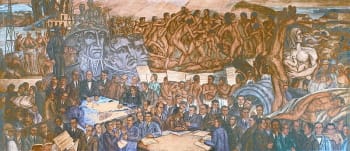
After seeing his frescos, La República (1937), at the Municipal Palace of Medellín, Arango contacted the artist Pedro Nel Gómez and soon joined a working group of women artists studying under his guidance. She felt in tune with Gómez and embraced his style, which was itself strongly influenced by Mexican Muralism. Her time with Gómez allowed her to learn about compositional dynamics and the vitality that can be achieved in painting through movement and color. Arango continued to develop her own practice and explored various themes in her work, adding urban scenes to her still-lifes and portraiture.
In 1937, Gómez's students put on a successful group exhibition, and soon after, their mentor dared them to begin painting the female nude. It was a transgressive suggestion and Arango was the only one of the group to accept Gómez's challenge. Having ceased to study with Gómez in 1938, she continued to explore the female nude genre independently.
Mature Period
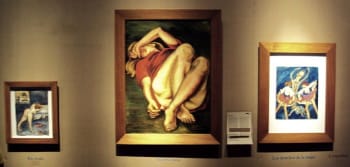
In 1939, Arango was invited to take part in the "Professional Artists Salon" at Club Unión, the most prestigious social center in Medellín, by the Society of Friends of Art. Of the 15 invited exhibitors, at least 13 were considered professional artists. Arango selected nine paintings for the exhibition, including two recent life-size nude watercolors: Cantarina de La Rosa (Singer of the Rose) (1939) and La Amiga (The Friend) (1939). They attracted instant controversy. Nevertheless, the three-man jury decided to award the first prize to Arango, choosing the more benign, The Sisters of Charity (1939), for the prize to offset the outrage. The scandal of her nudes would not go away, however.
On the day the prize was announced, an article signed with the initials "L. P." was published in the conservative newspaper La Defensa calling Arango's work a "shameless work signed by a lady that not even a man should exhibit". The article also refers to the artwork La Amiga as being only "appropriate for hanging in a brothel". The liberal newspaper El Diario defended Arango, however, and publishing her first interview in November 1939. In the article, she defended her right to paint nudes, stating, "I am convinced that art as a cultural manifestation does not have to have anything to do with moral codes. Art is neither amoral nor immoral. Its orbit simply does not intersect any ethical principle".
In the spring of 1940, Arango was invited by the Liberal Education Minister, Jorge Elicer Gaitán, to exhibit her paintings in Bogotá in her first solo exhibition. The exhibition opened in October at the foyer of the prestigious Teatro Colón and was comprised of thirteen watercolors, six of which were life-size female nudes. Once more, the nudes - that featured pubic hair and bare nipples - caused a backlash, but this time the controversy was elevated to a national level. The newspaper, El Siglo, directed by the politician, and future president, Laureano Gómez, published an anonymous article describing the exhibition as a "challenge to good taste". It described Arango, indeed, as "a young woman without artistic taste, who shows that she does not even have elementary notions of drawing and that she does not know the technique of watercolor". (It was reported in the paper that the exhibition had been shut down when in fact it had remained open to the public.)
After the exhibition, Arango's art took a critical shift as she started addressing social themes, particularly those that affected lower-class Colombian women. This renewed approach to her art (which seemed to contradict her earlier declaration that art should not concern itself with matters of morality) made her the first Colombian artist to depict scenes of prisons, bars, brothels and asylums (to which she gained access through her brothers' connections). Her frank treatment of her subjects - images of the harassment faced by prostitutes at the hands of the police, mental illness in prison, and even a prisoner giving birth unaided - had never been seen in Colombian art. During this period, her art also became more expressionistic too.
Arango's art had caused such a scandal that, around 1945, her father received a direct phone call from the parish priest informing him the archbishop would ex-communicate his daughter if she continued to exhibit her work. In response, Arango left Colombia for Mexico where she lived for at least three months. While there, she enrolled at the National School of Fine Arts. Arango studied fresco, and became strongly influenced by the work of José Clemente Orozco. In 1947 she was compelled to return to Medellín to take care of her father, who had recently fallen ill.
Late Period
Following the assassination of the liberal presidential candidate, Jorge Elicer Gaitán, in 1948, Arango's art took another thematic shift. Her painting Masacre del 9 de Abril (Massacre of April 9) (1948) documents the 10 hours of violence and riots that erupted in Bogotá after the assassination of Gaitán, and which became known as El Bogotazo. After this event, her art focused mainly on political satire, documenting different events of the period known as La Violencia (The Violence), and challenging corruption in the Colombian government. These works would remain hidden from the public for two decades by the Colombian authorities.
In 1954 Arango traveled to Europe and stayed in a pension guesthouse in Madrid for almost two years. Here she focused on studying movement and the human figure and the mural paintings at The Academy of San Fernando. In February 1955, Arango opened an exhibition with thirty of her works at the Institute of Hispanic Culture. However, it was shut down the next day by order of the Francoist regime. Having returned to Colombia, Arango exhibited a series of ceramics (which she had worked on while caring for her father) at the Centro Colombo-Americano de Medellín. Two years later, she displayed 37 paintings at the Marian Congregation, but the political climate made her fear for the safety of her work, and she removed the paintings from display. After the premature ending of the exhibition, Arango did not display her work for many years and, by 1960, she had abandoned participation in public events altogether.
In 1975, Arango reemerged in public life when the Biblioteca Pública Piloto in Medellín hosted a retrospective of her art, exhibiting approximately a hundred works. Art Historian Fernández Uribe noted that while the retrospective did not receive the attention it deserved, "it had the unquestionable merit of reminding critics and artists of the painter's existence". Galvanized by the exhibition, Arango returned to painting for two years and produced various new satirical oil paintings and watercolors of topics related to the human condition and social customs.
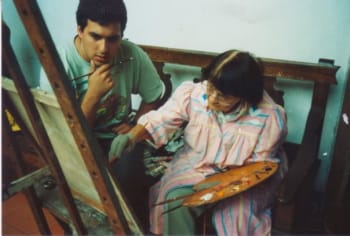
1984 marked a late career turning point for Arango when the recently founded Museo de Arte Moderno de Medellín presented a retrospective featuring 205 works, ranging from oil painting to watercolor and ceramics. Three years later, Arango donated 233 of her works to the museum, which today makes up the most important part of the museum's collection, and the most extensive public collection of her art. In 1997, and then again in 2003, she received the Cruz de Bocayá, the most important peacetime honor from the government of Colombia. Art critic, Juan Forero wrote, "In old age, she continued to work, her paintings climbing the walls of her beloved house in the town of Envigado. She delighted in having visitors, surprising them with her sharp wit". She created her last painting, Portrait of a Friend, her best friend and apprentice, Mateo Blanco, in 2003. Arango died on December 4, 2005, aged 98.
The Legacy of Débora Arango
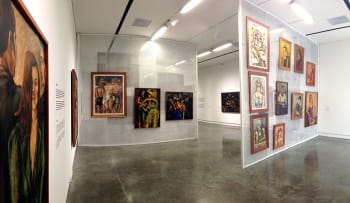
Throughout her eight decade career, Arango produced art that tested the conservative mindset of Colombia's art establishment. Her art celebrated the naked female; it spoke up for the subaltern women who had never been represented in Columbian art before; and later she dared to criticize the violence and political corruption that stained daily Colombian life. Her art was transgressive and satirical, and it put down a marker for those female Colombian artists that followed, including Beatriz González, Doris Salcedo, and Karen Paulina Biswell.
Forero notes that "As Colombia opened itself up to the world and produced celebrated artists like Mr. [Fernando] Botero and writers like Gabriel García Márquez, Ms. Arango's work eventually found acceptance and critical acclaim". He adds that, although she held successful exhibitions in Spain and the United States, "Arango never sought fame and was reluctant to have her paintings shown". Today, however, her work forms part of the bigger narrative on 20th century Latin-American women artists. Indeed, she joins the company of Frida Kahlo, María Izquierdo and Tarsila do Amaral as modernist pioneers amongst female Hispanic artists.
Influences and Connections

-
![José Clemente Orozco]() José Clemente Orozco
José Clemente Orozco - Eladio Vélez
- Pedro Nel Gómez
- Mateo Blanco
-
![Expressionism]() Expressionism
Expressionism - Muralism
-
![Doris Salcedo]() Doris Salcedo
Doris Salcedo - Joaquín Ristrepo
- Beatriz González
- Karen Paulina Biswell
- Mateo Blanco
-
![Expressionism]() Expressionism
Expressionism - Muralism
Useful Resources on Débora Arango
- Débora Arango: vida de pintura (In Spanish)Our PickBy Santiago Londoño Vélez
- Débora Arango: The Art, sublime revengeBy Ángel Galeano
- Débora Arango: Cuaderno de notas (In Spanish)By Santiago Londoño Vélez
 Ask The Art Story AI
Ask The Art Story AI